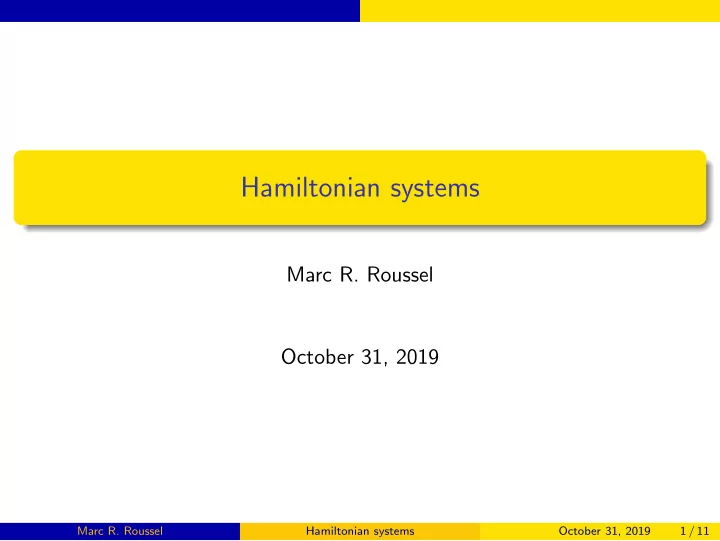

Hamiltonian systems Marc R. Roussel October 31, 2019 Marc R. Roussel Hamiltonian systems October 31, 2019 1 / 11
Hamiltonian systems Suppose that we have a dynamical system whose equations of motion are related to a function H ( x , p ) by x i = ∂ H p i = − ∂ H ˙ , ˙ ∂ p i ∂ x i Such a system is called a Hamiltonian system. H ( x , p ) is called the Hamiltonian function, or just the Hamiltonian. If the vectors x and p are elements of R n , then we say that n is the number of degrees of freedom. The phase space is 2 n -dimensional. Marc R. Roussel Hamiltonian systems October 31, 2019 2 / 11
Significance of the Hamiltonian The Hamiltonian is a conserved quantity. To see this, differentiate H ( x , p ) with respect to time using the chain rule: n n dH ∂ H dx i ∂ H dp i � � dt = dt + ∂ x i ∂ p i dt i =1 i =1 n n ∂ H ∂ H ∂ H � − ∂ H � � � = + ∂ x i ∂ p i ∂ p i ∂ x i i =1 i =1 = 0 Marc R. Roussel Hamiltonian systems October 31, 2019 3 / 11
Conservative mechanical systems are Hamiltonian Example: harmonic oscillator Consider a harmonic oscillator with Hooke’s law force F = − kx Since F = dp dt (most general form of F = ma ) dp dt = − kx Also, dx dt = v = p / m Marc R. Roussel Hamiltonian systems October 31, 2019 4 / 11
Conservative mechanical systems are Hamiltonian Example: harmonic oscillator (continued) dx dp dt = p / m dt = − kx If this system is Hamiltonian, then we must have ∂ H ∂ H ∂ p = p / m and ∂ x = kx Marc R. Roussel Hamiltonian systems October 31, 2019 5 / 11
Conservative mechanical systems are Hamiltonian Example: harmonic oscillator (continued) From ∂ H ∂ p = p / m , we get H = p 2 2 m + f ( x ) And from ∂ H ∂ x = kx , H = 1 2 kx 2 + g ( p ) Therefore 2 kx 2 + p 2 H = 1 2 m Marc R. Roussel Hamiltonian systems October 31, 2019 6 / 11
Dissipative mechanical systems are not Hamiltonian If we take F = dp dt = − kx − µ v which includes a frictional (dissipative) term − µ v , we get a system that is not Hamiltonian. Try it! Marc R. Roussel Hamiltonian systems October 31, 2019 7 / 11
Hamiltonian systems in two dimensions For a two-dimensional Hamiltonian system, the Hamiltonian H ( x , p ) defines solution curves in phase space. Example: harmonic oscillator with k = 200 N m − 1 and m = 0 . 1 kg 0.1 0.05 E /J 0.04 0.03 p /kg m s -1 0.02 0 0.01 -0.05 0.02 -0.1 -0.02 -0.01 0 0.01 x /m Marc R. Roussel Hamiltonian systems October 31, 2019 8 / 11
Integrability The Poisson bracket of two functions H ( x , p ) and L ( x , p ) is defined by n � ∂ H ∂ L − ∂ H ∂ L � � { H , L } = ∂ p i ∂ x i ∂ x i ∂ P i i =1 differentiable functions. L ( x , p ) is a first integral of a Hamiltonian system if ˙ L = 0. L ( x , p ) is a first integral of a system with Hamiltonian H ( x , p ) if { H , L } = 0. A Hamiltonian system with n first integrals is completely integrable. Marc R. Roussel Hamiltonian systems October 31, 2019 9 / 11
An example: particle in a two-dimensional harmonic trap A Paul trap holds ions in a well-defined region of space using electric fields. Overall, the potential is harmonic and can have a spherical geometry, or hold the ions in a relatively flat disk. Hamiltonian for a two-dimensional ion trap: H = p 2 x + p 2 + 1 2 k ( x 2 + y 2 ) y 2 m Since there is no external torque, the angular momentum L = xp y − yp x should be a constant of the motion. (Check this.) Marc R. Roussel Hamiltonian systems October 31, 2019 10 / 11
Particle in a two-dimensional harmonic trap (continued) We have two degrees of freedom and two first integrals ( H and L ) so this system is completely integrable. The trajectories lie at the intersection of H ( x , y , p x , p y ) = E and L ( x , y , p x , p y ) = ℓ . This intersection is a two-dimensional surface in the four-dimensional phase space. Marc R. Roussel Hamiltonian systems October 31, 2019 11 / 11
Recommend
More recommend